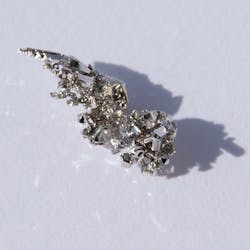Precious metal tracks nanoplastics in wastewater
ZURICH, SWITZERLAND & WASHINGTON DC, MARCH 13, 2019 -- Tiny plastic particles measuring about 100 nanometers (millionths of a millimeter) are used in many products, for example to encapsulate dye or aromatic substances or as additives to shampoos and cosmetics. Many of them land directly in sewage as soon as the products are used. Together with other plastics, for example from tire rubber in road run-off, they end up in the water-treatment plants. But until now it has not really been possible to measure them there. Unlike larger particles (microplastics), they cannot simply be sieved out and weighed or counted. In addition, it was unclear, except in models, how much nanoplastic was retained in water-treatment plants and how much entered the environment.
Now a group of researchers from Eawag and the ETH Zurich have developed a method that enables the tracking of nanoplastics: they have produced plastic particles with the precious metal palladium built into the center of the particle. This can be relatively easily analyzed using standard methods. In their article in the present issue of nature nanotechnology, the researchers show how they have successfully used the method on a laboratory scale to study the behavior of nanoplastics in the activated sludge process of a water-treatment plant. According to project leader Denise Mitrano, the nanoplastic particles bind very quickly to the sludge flocculate, resulting in an ultimate elimination level of over 98%. "As long as the sludge is not spread on fields, but burned, as is the practice in Switzerland, very little nanoplastic material makes it into the environment," says Mitrano.
This is a positive result. But it is also clear to Mitrano: "We need to know much more about the behavior of nanoplastics. Even if only small percentages make it into surface waters, these can add up to higher concentrations downstream". She now hopes that her method, used on traceable particles, will quickly lead to new insights. As the palladium in the core of the nanoplastic particles is firmly bound, it is even possible to trace whether the particles produced in the laboratory are taken up by organisms, and to do controlled eco-toxicity tests. Projects using the tagged particles are already running, including a joint project between Eawag and the Zurich water utility on the retention of nanoplastics during drinking water purification.
